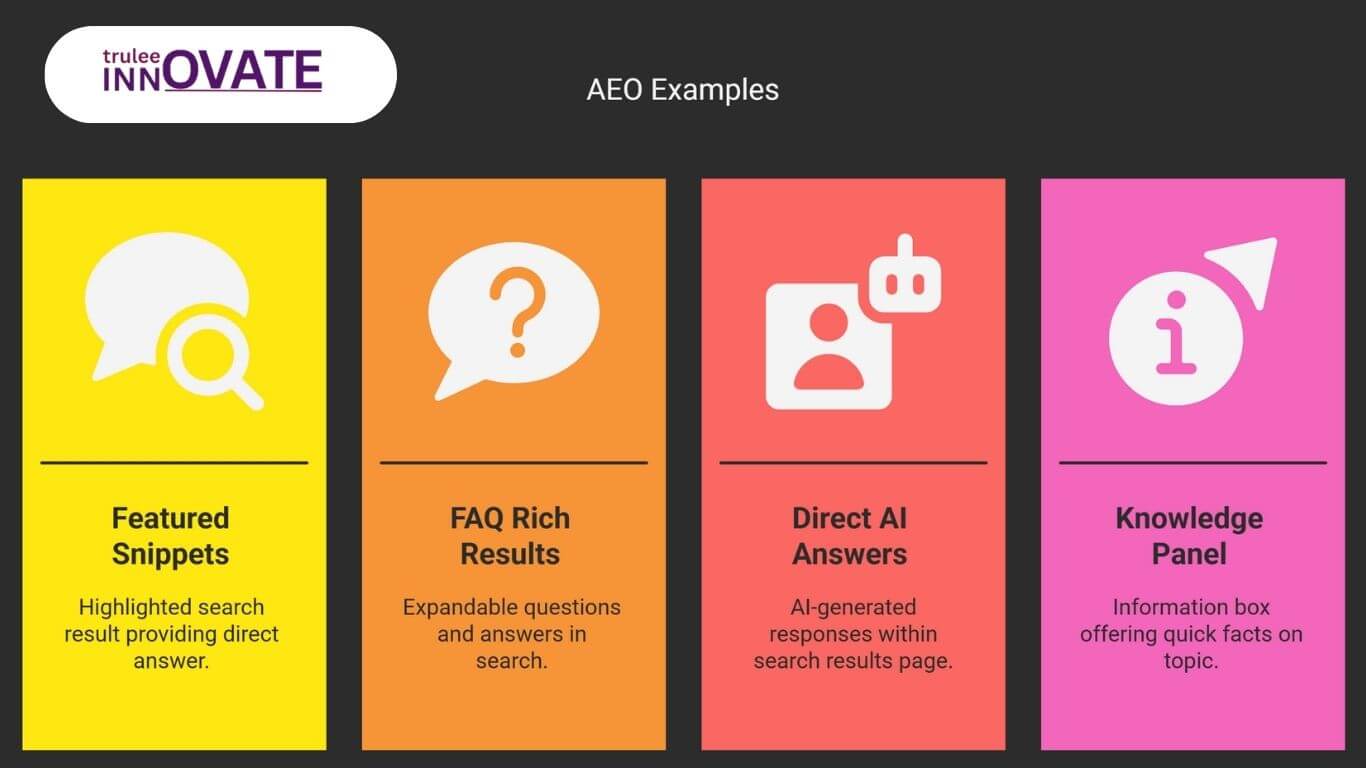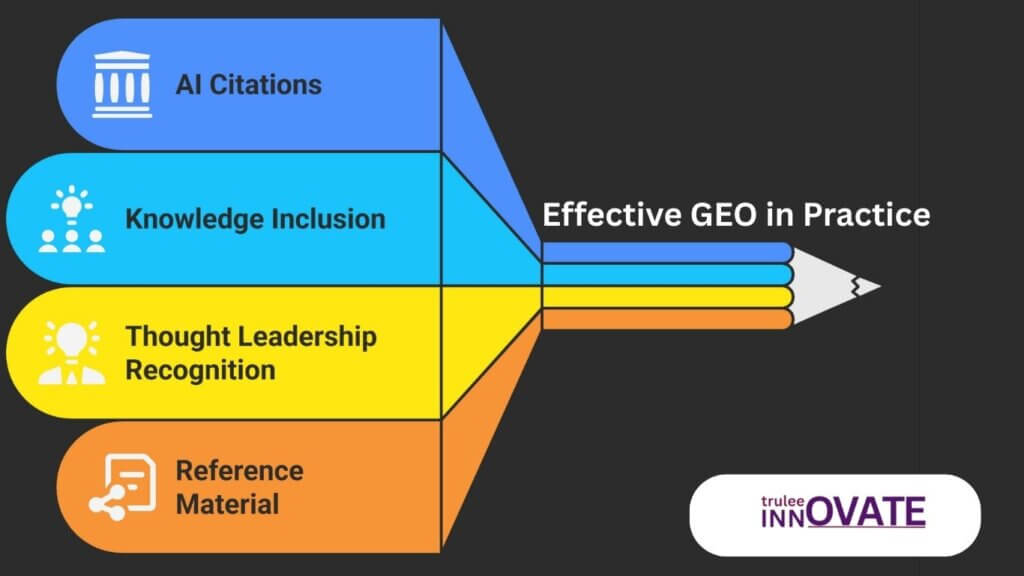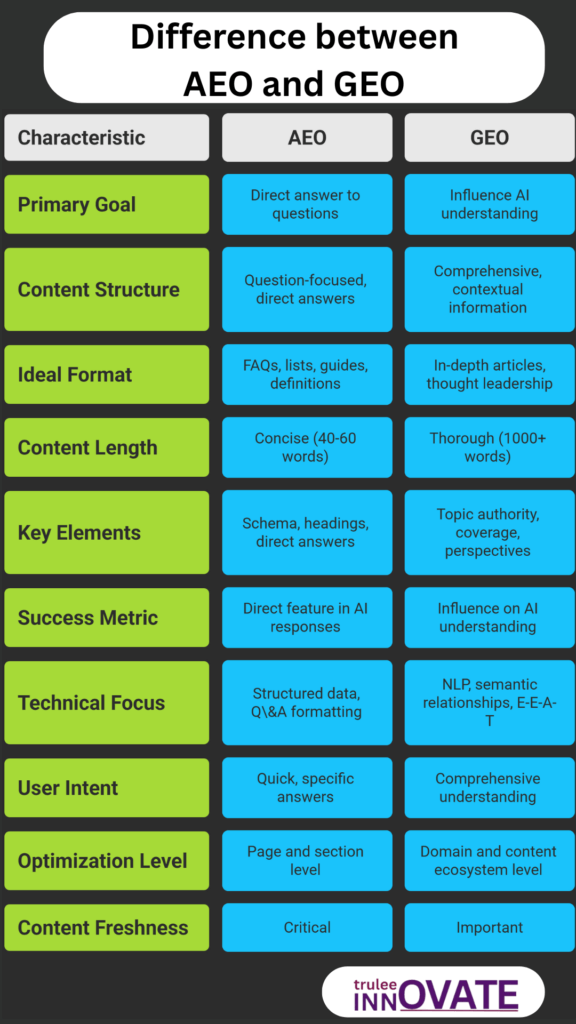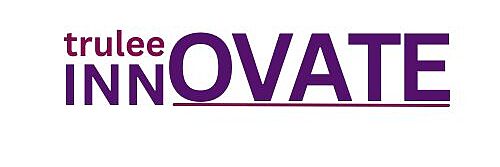Introduction: Is SEO Dead or Evolving?
Is SEO Dead or Evolving?
Traditional SEO is no longer the sole strategy in use due to the quick ascent of AI-powered search engines like ChatGPT, Google SGE, and Bing AI. AI-driven tools are transforming how information is searched, retrieved, and presented to users. AI is now providing users with direct, conversational responses in place of the usual list of blue links
This shift is giving rise to two emerging SEO strategies:
AEO (Answer Engine Optimization) – The practice of structuring content to provide direct, concise answers that AI engines can deliver instantly to users. Like FAQs, snippets, and structured Q&A content.
GEO (Generative Engine Optimization) – The approach of creating comprehensive, in-depth content that AI tools use to generate responses, summaries, and recommendations. This content is designed to be cited or referenced by AI, increasing its reach and authority.
But why does this matter to businesses?
In a world where AI engines are becoming the first touchpoint for information discovery, failing to optimize for AEO and GEO means missing out on visibility in AI-driven search results. Businesses must adapt their content strategies to ensure their content is seen, referenced, and cited by AI engines to stay competitive.
What Is AEO (Answer Engine Optimization)?
Answer Engine Optimization (AEO) refers to the practice of structuring and formatting content specifically to be selected as direct answers by AI systems and search engines. Unlike traditional SEO that focuses on ranking in search results pages, AEO aims to position your content as the singular, authoritative answer that an AI tool will provide directly to users.
AEO works with systems like Google’s Search Generative Experience (SGE), Bing AI, and standalone AI assistants like ChatGPT by making content easily parsable and directly answerable. These tools are designed to extract precise responses to user queries, so AEO focuses on structuring information to facilitate this extraction process.
Real-world examples of AEO in action include:
- Featured Snippets: When Google extracts a definition, steps, or short answer from your webpage and displays it at the top of search results.
- FAQ Rich Results: Structured question-and-answer content that appears directly in search results, often with expandable sections.
- Direct AI Answers: When tools like ChatGPT or Google SGE quote or paraphrase your content directly when answering user questions.
- Knowledge Panels:Information boxes that show important details about things (people, locations, and organizations) that show up in search results.
The goal of AEO is to become the definitive source that AI tools reference when users ask questions related to your expertise. This requires clarity, conciseness, and authoritative information structured in ways that facilitate AI comprehension and extraction.

What Is GEO (Generative Engine Optimization)?
Generative Engine Optimization (GEO) is the strategic approach to creating content that influences how generative AI systems summarize, synthesize, and create new content based on your published information. While AEO focuses on direct answers, GEO acknowledges that AI often generates new content by drawing from multiple trusted sources.
GEO works by understanding how large language models (LLMs) like GPT-4, Claude, and others process information during both their training phase and when generating responses. These models aren’t simply extracting answers; they’re creating new content based on patterns recognized across their vast training data and the specific sources they cite.
Examples of effective GEO in practice include:
- AI Citations: When systems like ChatGPT specifically mention your website or content as an authoritative source.
- Knowledge Inclusion: When your unique insights, data, or terminology become incorporated into AI-generated responses, even without direct attribution.
- Thought Leadership Recognition: When AI systems consistently draw from your perspective or framework when discussing topics in your domain.
- Reference Material: Content that AI tools recommend for further reading or deeper understanding of a topic.
The core difference is that GEO focuses less on individual answers and more on becoming part of the AI’s knowledge foundation – influencing how it understands and explains entire topics or fields. This requires comprehensive, unique, and authoritative content that AI systems will recognize as valuable for synthesizing information.

AEO vs GEO: What’s the Difference?
Understanding the distinct approaches of AEO and GEO is essential for developing a comprehensive AI search optimization strategy. Here’s how they compare across key dimensions:
| Aspect | Answer Engine Optimization (AEO) | Generative Engine Optimization (GEO) |
|---|---|---|
| Primary Goal | To be the direct, quoted answer to specific questions | To influence AI’s understanding and synthesis of topics |
| Content Structure | Highly structured, question-focused, direct answers | Comprehensive, contextual, interconnected information |
| Ideal Format | FAQs, lists, step-by-step guides, definitions | In-depth articles, thought leadership, unique insights |
| Content Length | Concise, to-the-point (often 40-60 words per answer) | Thorough exploration (1000+ words with semantic depth) |
| Key Elements | Schema markup, clear headings, direct answers | Topic authority, comprehensive coverage, unique perspectives |
| Success Metric | Direct feature in AI responses, featured snippets | Influence on AI’s understanding, citations, recommendations |
| Technical Focus | Structured data, question-answer formatting | Natural language processing, semantic relationships, E-E-A-T signals |
| User Intent | Serves users seeking quick, specific answers | Serves users (and AI) needing comprehensive understanding |
| Optimization Level | Page and section level | Domain and content ecosystem level |
| Content Freshness | Critical – outdated answers get replaced | Important but more forgiving if foundationally valuable |

While these approaches differ, they’re not mutually exclusive. The most effective AI optimization strategy often incorporates elements of both, tailored to specific content purposes and user needs.
How to Optimize for AEO: Answer-Based Content Strategy
Creating content that AEO engines favor requires a methodical approach focused on clarity, structure, and direct answers. Here’s how to implement an effective Answer Engine Optimization strategy:
Focus on Question-Based Content
The foundation of AEO is understanding and addressing the specific questions users ask:
- Research common questions in your niche using tools like AnswerThePublic, BuzzSumo Question Analyzer, or by studying the “People Also Ask” sections in Google search results.
- Structure content with question headings that match natural language queries (e.g., “What is interview outsourcing?” rather than just “Interview Outsourcing”).
- Create dedicated FAQ sections that address the most common questions in your field using clear question-answer formats.
- Cover different question types: “what,” “how,” “why,” “when,” and “where” questions to capture various query intents.
Implement Structured Data (Schema Markup)
AI systems can comprehend and classify your information more easily when you use structured data:
- For question-answer material, use the FAQ Schema to improve the probability of rich search results.
- Implement HowTo Schema for instructional content that outlines specific processes or methods.
- Add Article Schema with appropriate metadata including author information, publish date, and update date.
- Consider specialized schemas like Recipe, Product, or Event when applicable to your content.
Free tools like Google’s Structured Data Markup Helper or Schema.org’s templates can help implement these technical elements correctly.
Craft Direct, Informative Answers
The quality of your answers directly impacts your AEO success:
- Answer the question completely in the first paragraph following each question heading.
- Keep answers concise (40-60 words is often ideal for featured snippets).
- Leave out superfluous jargon and marketing talk in favor of plain, uncomplicated language.
- Include key facts, numbers, and statistics where relevant to increase answer authority.
- Format for scannability with bullet points, short paragraphs, and bolded key concepts.
- Avoid tangents that don’t directly address the question at hand.
Keep in mind that AEO aims to provide the best, most straightforward response to a given query. Every element of your content should serve this purpose while maintaining readability and value for human readers
How to Optimize for GEO: Generative AI-Focused Strategy
Generative Engine Optimization requires a more holistic approach that influences how AI systems understand entire topics. Here’s how to develop content that generative AI will reference, synthesize, and recommend:
Create Complete, In-Depth Content
Generative AI favors comprehensive coverage that demonstrates true expertise:
- Develop cornerstone content that exhaustively covers important topics in your field.
- Address multiple angles and perspectives to show complete understanding.
- Include supporting evidence, data, and research that strengthens your arguments.
- Connect related concepts to create semantic networks that demonstrate topical mastery.
- Anticipate and answer follow-up questions that naturally arise from your main topic.
The goal is to create content that serves as a definitive resource – something AI systems recognize as authoritative enough to draw from when generating their own explanations.
Use NLP-Friendly Language
Writing style is just as important as content:
- Prioritize clarity and coherence with well-structured sentences and logical paragraph flows.
- Use consistent terminology when referring to key concepts.
- Include synonyms and related terms to strengthen semantic relationships.
- Write in an authoritative but conversational tone that balances expertise with accessibility.
- Use transition words and phrases that clearly connect ideas and guide readers through your reasoning.
- Structure content with clear hierarchical headings (H1, H2, H3) that create a logical outline.
These practices make your content more easily “digestible” for natural language processing systems, increasing the likelihood it will influence AI-generated responses.
Establish Context, Relationships, and Credibility
Generative AI evaluates information within broader contextual frameworks:
- Position your content within the larger conversation in your industry or topic area.
- To increase your trustworthiness, cite and reference reliable sources..
- Link to related content both internally and externally to demonstrate interconnectedness.
- Add your distinct viewpoint or approach that sets your material apart.
- Be transparent about your qualifications and basis for expertise on the topic.
- Regularly update content to keep it authoritative and relevant.
Remember that GEO isn’t just about being found – it’s about influencing how AI systems understand and explain entire topics. Your goal is to become part of the knowledge foundation that generative AI draws upon.
Implementing E-E-A-T in AEO & GEO Strategies
Experience, Expertise, Authoritativeness, and Trustworthiness (E-E-A-T) have become increasingly important signals for both search engines and AI systems.Here’s how to apply these ideas to your AI optimization approach
Build and Demonstrate Experience
AI systems increasingly value first-hand experience:
- Share personal or organizational experiences related to your topic.
- Include case studies and examples from your direct work.
- Discuss lessons learned and practical applications rather than just theoretical knowledge.
- Use “we found” or “our experience shows” language when appropriate to signal direct experience.
- Create content that clearly demonstrates practical application rather than just compiled research.
Establish Expertise Signals
Make your expertise clear and verifiable:
- Include author data with relevant qualifications and experience.
- Add credentials and certifications where applicable.
- Reference your published works or contributions in the field.
- Demonstrate technical depth in your explanations that goes beyond surface-level information.
- Use appropriate specialized terminology correctly and with clear explanations.
Build Authoritativeness
Position your content as a go-to resource:
- Obtain and highlight endorsements from recognized experts or organizations.
- Secure backlinks from authoritative sites in your industry.
- Display relevant awards, affiliations, and partnerships.
- Maintain consistent topical focus across your content ecosystem.
- Create comprehensive resource sections that establish your site as a destination for information
Enhance Trustworthiness
Signal reliability and accuracy:
- Cite primary sources and research to support claims.
- Include author details and update dates on all content.
- Correct errors transparently with visible edit notes when appropriate.
- Maintain factual accuracy and avoid unsubstantiated claims.
- Clearly differentiate with fact from opinion in your content.
- Include full contact information and about pages on your site.
E-E-A-T signals are increasingly important for both human trust and AI evaluation. As AI systems become more sophisticated in assessing information quality, these elements will likely become even more crucial for content visibility and influence.
Why Natural Language Processing (NLP) Matters in AI SEO
Understanding how Natural Language Processing works can give you a significant advantage in optimizing for AI search. NLP is the technology that allows AI systems to understand, interpret, and generate human language – making it the foundation of how these tools evaluate your content.
How NLP Reads and Interprets Content
Modern NLP systems work through several sophisticated processes:
- Tokenization: Breaking text into words, phrases, or subwords for analysis
- Part-of-speech tagging: Identifying nouns, verbs, adjectives, etc.
- Named entity recognition: Identifying people, places, organizations, and other entities
- Dependency parsing: Understanding relationships between words in sentences
- Semantic analysis: Determining meaning and intent beyond just the words used
- Sentiment analysis: Detecting emotional tone and attitude
- Co-reference resolution: Tracking what pronouns and references point to
This multi-layered analysis means AI doesn’t just match keywords – it builds complex understanding of topics, relationships, and contexts.
Writing in a Human-Like, Conversational Tone
To align with how modern NLP works:
- Use natural language patterns rather than keyword-stuffed text.
- Vary sentence structure and length to maintain a natural reading flow.
- Address the reader directly where appropriate.
- Use analogies and examples to illustrate complex concepts.
- Balance technical accuracy with accessibility.
- Answer questions the way you would in conversation – directly and clearly.
The goal is content that reads naturally to humans while being easily processed by machines – avoiding both overly formal academic writing and artificially keyword-optimized text.
NLP Analysis Tools for Content Optimization
Several tools can help you analyze how NLP systems view your content:
- Google NLP API: Provides entity recognition, sentiment analysis, and content classification
- ChatGPT: Ask it to summarize or explain your content to see how it’s interpreted
- Clearscope or Frase: Offer topic and semantic analysis with optimization suggestions
- IBM Watson Natural Language Understanding: Provides detailed linguistic analysis
- MonkeyLearn: Offers customizable NLP analysis for specific industries or content types
Running your content through these tools can reveal gaps in clarity, coverage, or semantic relationships that might not be apparent through traditional SEO analysis.
By understanding and optimizing for NLP patterns, you create content that both current and future AI systems will more effectively process, understand, and reference – a critical advantage as search becomes increasingly AI-mediated.
Content Completeness: Give AI Engines Everything They Need
AI systems prioritize content that provides comprehensive coverage of topics. Creating complete content that addresses all aspects of a subject increases your chances of being referenced, cited, or directly quoted by AI tools.
Provide End-to-End Answers to User Queries
Complete content leaves no question unanswered:
- Address the primary question thoroughly before moving to related aspects.
- Anticipate and answer natural follow-up questions within the same content.
- Include both basic and advanced information to serve different knowledge levels.
- Cover prerequisites and next steps for procedural or educational content.
- Address common objections or misconceptions related to your topic.
This approach ensures that AI systems recognize your content as comprehensive enough to serve diverse user needs around a specific topic.
Cover Subtopics and Related Terms (Semantic Depth)
Semantic relationships strengthen your content’s authority:
- Identify and incorporate related concepts that users might search for.
- Use a variety of terms and phrases that connect to your main topic.
- Create sections addressing important subtopics within your main subject.
- Link subtopics together to show relationships and broader context.
- Use semantic HTML (like headings, lists, and emphasized text) to highlight concept relationships.
Tools like topic clustering software or even AI writing assistants can help identify semantic relationships you might otherwise miss.
Add Multimedia When Beneficial
Different content formats enhance understanding:
- Include relevant images that illustrate concepts or processes.
- Add diagrams or infographics that visualize relationships or data.
- Incorporate videos for demonstrations or explanations that benefit from visual motion.
- Use tables to organize comparative information clearly and concisely.
- Consider interactive elements for complex topics requiring exploration.
Content Completeness: Give AI Engines Everything They Need
AI algorithms favor content that covers a wide range of subjects. Creating complete content that addresses all aspects of a subject increases your chances of being referenced, cited, or directly quoted by AI tools.
Provide End-to-End Answers to User Queries
Complete content leaves no question unanswered:
- Address the primary question thoroughly before moving to related aspects.
- Anticipate and answer natural follow-up questions within the same content.
- Include both basic and advanced information to serve different knowledge levels.
- Cover prerequisites and next steps for procedural or educational content.
- Address common concerns or misconceptions linked to your issue
This approach ensures that AI systems recognize your content as comprehensive enough to serve diverse user needs around a specific topic.
Cover Subtopics and Related Terms (Semantic Depth)
Semantic relationships strengthen your content’s authority:
- Identify and incorporate related concepts that users might search for.
- Use a variety of terms and phrases that connect to your main topic.
- Create sections addressing important subtopics within your main subject.
- Link subtopics together to show relationships and broader context.
- Use semantic HTML (like headings, lists, and emphasized text) to highlight concept relationships.
Tools like topic clustering software or even AI writing assistants can help identify semantic relationships you might otherwise miss.
Add Multimedia When Beneficial
Different content formats enhance understanding:
- Include relevant images that illustrate concepts or processes.
- Add diagrams or infographics that visualize relationships or data.
- Incorporate videos for demonstrations or explanations that benefit from visual motion.
- Use tables to organize comparative information clearly and concisely.
- Consider interactive elements for complex topics requiring exploration.
While AI systems primarily process text, the presence of supportive multimedia signals comprehensive content that serves user needs more effectively – potentially increasing the likelihood of being cited as an authoritative source.
Remember that “complete” doesn’t mean exhaustive to the point of overwhelming. Rather, it means addressing the topic thoroughly enough that users (and AI) don’t need to seek additional sources to understand the subject fully within the context of their query.
Keep It Fresh: Why Regular Content Updates Are Crucial
In the AI search landscape, content freshness has taken on new importance. Both traditional search engines and AI systems prioritize current, accurate information – making regular updates a critical component of your optimization strategy.
AI’s Preference for Updated Information
AI tools are increasingly designed to favor recent information:
- Recency indicators like publication and update dates are factored into relevance calculations.
- AI systems often flag outdated information when providing answers.
- Citation preferences tend toward more recent sources when multiple options exist.
- “Current best practice” questions typically draw from fresher content.
- Temporal context is increasingly considered when evaluating information relevance.
This preference exists because AI systems are designed to provide the most accurate, up-to-date information possible – making freshness a proxy for potential accuracy.
Content Decay and SEO Ranking Drops
Outdated content faces multiple challenges:
- Gradual traffic decline as fresher content supersedes older material.
- Reduced click-through rates when users see outdated timestamps.
- Decreased engagement metrics as information becomes less relevant or accurate.
- Lost featured snippet positions to more current content.
- Diminished authority signals as older content gathers fewer new backlinks or shares.
This phenomenon, known as “content decay,” can affect even previously high-performing pages if they aren’t regularly refreshed.
Creating a Content Refresh Schedule
Implement a systematic approach to content updates:
- Audit content by topic categories to identify update priorities.
- Set different update frequencies based on content type:
- News-related content: As developments occur
- Industry trend content: Quarterly
- Statistical information: Annually or when new data is available
- Foundational/evergreen content: Every 6-12 months
- Technical instructions: When processes or tools change
- Monitor performance metrics to identify content showing signs of decay.
- Check for factual accuracy during each update cycle.
- Update examples, screenshots, and references to reflect current context.
- Add new information and insights rather than simply changing dates.
- Signal updates clearly with visible “last updated” timestamps and, when appropriate, change logs.
By maintaining content freshness, you signal to both users and AI systems that your information remains relevant and reliable – increasing the likelihood that AI tools will reference or recommend your content when answering related queries.
Final Thoughts: Prepare for the Future of AI-Driven Search
The search landscape is undergoing its most significant transformation since the rise of mobile. As AI increasingly mediates information discovery, understanding and implementing both AEO and GEO strategies will be crucial for maintaining digital visibility.
The Dual Optimization Approach
Success in AI search requires balancing both AEO and GEO:
- AEO ensures your content addresses specific questions with clear, direct answers that AI systems can extract and present to users.
- GEO positions your content as foundational knowledge that influences how AI understands and explains entire topics or fields.
Together, these approaches create a comprehensive optimization strategy that addresses both immediate user queries and broader topical authority.
Future-Proofing Your Content Strategy
As AI search continues to evolve, certain principles will remain essential:
- Prioritize genuine expertise and value over technical optimization tricks.
- Focus on solving user problems comprehensively and clearly.
- Embrace structured data as communication between your content and AI systems.
- Monitor AI search developments to adapt strategies as capabilities change.
- Test your content performance directly with AI tools to gauge effectiveness.
The organizations that thrive in this new ecosystem will be those that view AI not as an obstacle but as an opportunity to create more valuable, accessible, and useful content. At TruleeInnovate, we’re committed to staying ahead of emerging technologies and implementing advanced strategies to deliver impactful results for your business.
Frequently Asked Questions
What’s the biggest difference between traditional SEO, AEO and GEO?
Traditional SEO focuses on ranking in search result pages through factors like keywords, backlinks, and technical optimization. AEO and GEO instead focus on being the source that AI tools directly quote, reference, or synthesize when answering user queries. While traditional SEO is about being found, AEO/GEO is about being cited and referenced directly within AI-generated answers.
Do I need to choose between AEO and GEO?
Why to choose if both are giving an effective approach in implementing both strategies across your content ecosystem. Use AEO tactics for content addressing specific questions and immediate user needs, while applying GEO principles to establish broader topical authority that influences AI understanding. Different content pieces can lean more heavily toward one approach or the other depending on their purpose.
Will optimizing for AI hurt my traditional search rankings?
When done properly, optimizing for AI search generally improves traditional search performance as well. The underlying principles – comprehensive coverage, clear structure, expertise signals, and user-focused content – align with what search engines already value. The main difference is more intentional formatting and structure to make information more accessible to AI systems.
How can I measure success in AEO and GEO?
For AEO, track:
- Featured snippets and rich results appearances
- Direct quotes in AI tools like ChatGPT or Bing AI
- “People Also Ask” inclusions
- Voice search answer selections
For GEO, monitor:
- Citations and mentions in AI-generated content
- Influence on AI explanations in your topic area
- Recommendations by AI tools for further reading
- Semantic coverage scores in content analysis tools
Do I need special technical skills to implement AEO and GEO?
Basic implementation can be achieved without specialized technical skills by focusing on content structure, clarity, and comprehensiveness. More advanced optimization may benefit from:
- Schema markup implementation (for AEO)
- Natural language processing analysis (for GEO)
- Structured data testing
- Content semantic analysis
However, many user-friendly tools now exist to help content creators implement these techniques without deep technical expertise.


